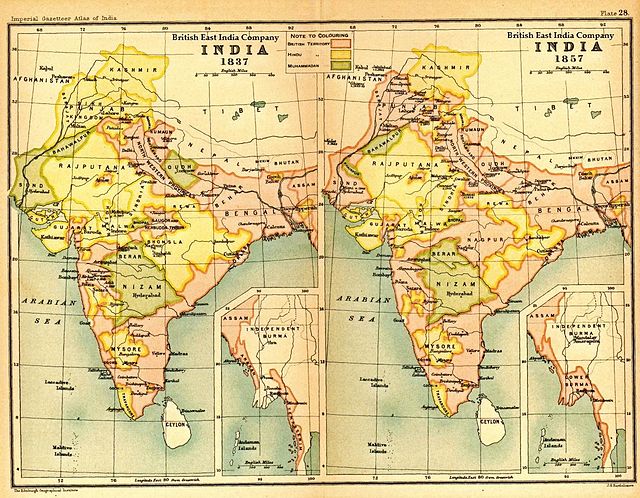Company rule in India was the rule of the British East India Company on the Indian subcontinent. This is variously taken to have commenced in 1757, after the Battle of Plassey, when the Nawab of Bengal Siraj ud-Daulah was defeated and replaced with Mir Jafar, who had the support of the East India Company; or in 1765, when the Company was granted the diwani, or the right to collect revenue, in Bengal and Bihar; or in 1773, when the Company abolished local rule (Nizamat) in Bengal and established a capital in Calcutta, appointed its first Governor-General, Warren Hastings, and became directly involved in governance. The Company ruled until 1858, when, after the Indian Rebellion of 1857 and the Government of India Act 1858, the India Office of the British government assumed the task of directly administering India in the new British Raj.
Areas of South Asia under Company rule (a) 1774–1804 and (b) 1805–1858 shown in two shades of pink
India in 1765 and 1805 showing East India Company Territories in pink.
India in 1837 and 1857, showing East India Company-governed territories in pink.
Silver Half-Rupee 1787 Bengal Presidency, Murshidabad Mint, issued in the name of Shah Alam II, Mughal Emperor
The East India Company (EIC) was an English, and later British, joint-stock company founded in 1600 and dissolved in 1874. It was formed to trade in the Indian Ocean region, initially with the East Indies, and later with East Asia. The company gained control of large parts of the Indian subcontinent and colonised parts of Southeast Asia and Hong Kong. At its peak, the company was the largest corporation in the world by various measures and had its own armed forces in the form of the company's three presidency armies, totalling about 260,000 soldiers, twice the size of the British army at the time.
James Lancaster commanded the first East India Company voyage in 1601
Red Dragon fought the Portuguese at the Battle of Swally in 1612, and made several voyages to the East Indies
The emperor Jahangir investing a courtier with a robe of honour, watched by Sir Thomas Roe, English ambassador to the court of Jahangir at Agra from 1615 to 1618, and others
A document with the original vermilion seal of Tokugawa Ieyasu, granting trade privileges in Japan to the East India Company in 1613








